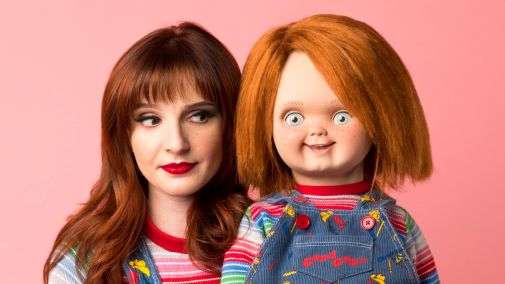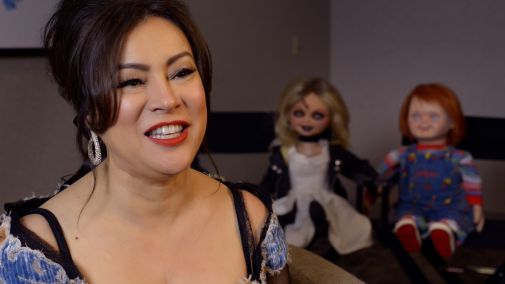Doc Corner: It's Child's Play and 'Living with Chucky'
 Friday, April 7, 2023 at 9:00AM
Friday, April 7, 2023 at 9:00AM 
No space within movie fandom feels more like a genuine community like the space taken up by horror. Not to get too Vin Diesel in The Fast and the Furious franchise, but for many, horror is a family that ties and binds people together. Even more so for queer lovers of the horror genre. Horror is particularly amenable to subtextual readings as well as straight-up camp and gay storytelling for many reasons, but that bond comes at least partly because horror (as a broad concept) and LGBTQ+ people have so much in common. Not that you need me to tell you any of that.
These narrative strands come together in Kyra Elise Gardner’s Living with Chucky. Ostensibly a documentary about the killer doll franchise that began as Child’s Play and has morphed more famously into The House of Chucky. It is also a telling of how this franchise was able to do what it did and remain relevant three decades later. Gardner is the daughter of one of the visual effects and puppeteer masters who’s brought Chucky to life over the years, so you could say she has particular insight.
In case you’ve forgotten, Chucky (the doll) is possessed by the soul of serial killer Charles Lee Ray (played and predominantly voiced by Brad Dourif). When that doll, a Good Guy with bright red hair and colourful child-friendly clothes, is given as a gift to young Andy Barclay (Alex Vincent), all hell breaks loose. Chucky follows Andy across several films. Chucky is later resurrected by a past love named Tiffany (Jennifer Tilly) who is then turned into a doll herself. They have a child named Glen/Glenda (voiced by Lord of the Rings’ Billy Boyd) who is either non-binary or transgender. Then into the picture came a woman called Nica who crosses paths with Andy in an institution and Chucky discovers how to split his soul between multiple dolls.
Got all of that?
Look, these movies are all very fun. 1998’s Bride of Chucky is my particular favourite and was the moment that the franchise became more than just the killer doll movies, but something more interesting, something queerer, something more unhinged. As a franchise, these movies are fascinating, with their own distinct eras and yet strangely unified in their storytelling. Something that has only been amplified by the SyFy Chucky series that has continued the saga into prime time.
This is Gardner’s first feature film as director and it shows. The problem with Living With Chucky isn’t the content necessarily, but how it is edited and structured within itself. Its first hour is devoted to each of the individual films within this sprawling franchise, beginning with 1988’s Child’s Play to 2017’s Cult of Chucky. This documentary was in production during the current (excellent!) television adaptation and the 2019 remake/reboot with Aubrey Plaza and Mark Hamill is rightfully left out. As it weaves through each of the seven films, distinct and interesting works, it recalls the In Search of Darkness films. New (mostly solid) interviews, behind-the-scenes material, old EPK footage and (of course) movie clips are assembled. It’s fun, if not particularly exciting storytelling.

Its final stretch is devoted to the family that these movies have built along the way. Particularly the influence of its original creator and spiritual father Don Mancini, and the way he has built these films and these sets to be inclusive spaces where many different voices are heard. It speaks loving to this series as one entirely unique within the horror realm, which is why it has such a devoted following among the horror community. I would have probably preferred these parts to be more organically integrated into the decades-long narrative that Gardner is telling. As it is, it’s clunky and misshapen.
Elsewhere, there are other oddities. Marlon Wayans, Lin Shaye and Abigail Breslin are also on board to discuss the impact of horror, although they hold no relevance at all to the Child’s Play/Chucky franchise. Perhaps they were remnants from an earlier, broader parse at the subject of the family of horror movie sets, but which appear out of place in its current final form. I understand ditching names like Wayans and Shaye when you have them sounds like a dumb choice, but their inclusion proves confusing.
It is a treat to see almost all of the franchise’s most important figures talking about a film series that deserves this sort of revelatory treatment. Particularly so when interviewing the Dourif father and daughter together, the incredibly smart Mancini, and Gardner’s own father. Jennifer Tilly is always fun to watch, too, and with that real voice a trip, too. It is obvious that Gardner comes to Living with Chucky with love and a very deep fondness for the franchise and all that it offers both herself personally as well as its dedicated fanbase who will surely love this doc. The final product does, however, lack polish and the voice of other recent horror documenaties like Scream, Queen! which is a shame because Chucky and his crew deserve it.
Release: Now streaming on ScreamBox in the US and a variety of other services across US and Canada.
 Child's Play,
Child's Play,  Chucky,
Chucky,  Doc Corner,
Doc Corner,  Jennifer Tilly,
Jennifer Tilly,  Review,
Review,  documentaries
documentaries 

